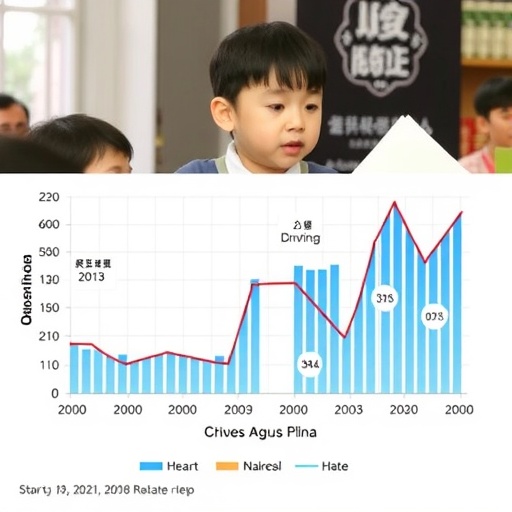
Childhood obesity has escalated into one of the most pressing public health crises worldwide, with China experiencing particularly alarming trends over the past two decades. Recent comprehensive research published in the International Journal of Obesity sheds light on the trajectory of childhood overweight and obesity in China from the year 2000 through 2019, providing critical projections up to 2030. This large-scale epidemiological study marks a crucial step in understanding the geographic and demographic disparities driving these trends, emphasizing the urgent need for refined governance and public health strategies at local and provincial levels.
The investigation harnessed a wealth of nationally representative data collected over 19 years, analyzing the prevalence and dynamic changes in childhood overweight status, which includes obesity, across all Chinese provinces. Unlike prior studies that broadly assessed national obesity data, this research presents a nuanced provincial analysis, delineating the complex interplay between urbanization, economic development, regional lifestyles, and childhood health indicators. This granularity in data allows policymakers and health professionals to identify high-risk areas and tailor interventions more effectively.
Over the two decades surveyed, the data reveal a disturbing and relentless upward trajectory in childhood overweight prevalence throughout China. The study underscores that, despite numerous public health efforts, overweight rates among children have not plateaued or declined but instead continue to rise, reflecting changing environmental, dietary, and behavioral factors prevalent across the country. This rising trend transcends socioeconomic strata, indicating a widespread public health concern that threatens future adult populations’ wellbeing and the national health system’s sustainability.
.adsslot_3MoKIAmYud{ width:728px !important; height:90px !important; }
@media (max-width:1199px) { .adsslot_3MoKIAmYud{ width:468px !important; height:60px !important; } }
@media (max-width:767px) { .adsslot_3MoKIAmYud{ width:320px !important; height:50px !important; } }
ADVERTISEMENT
Significantly, the study projects these trends forward to the year 2030, employing sophisticated modeling techniques that factor in current trajectories, demographic changes, and socioeconomic developments. These projections suggest a continued increase in childhood overweight prevalence, potentially reaching unprecedented levels if comprehensive and immediate interventions are not implemented. The study’s forecasting model highlights that without a strategic recalibration in local governance, urban planning, and nutritional policies, the incidence of childhood overweight could substantially burden healthcare infrastructure and economic productivity in coming years.
One of the pivotal findings relates to disparities in prevalence by sex and province. The research delineates a clear difference in overweight rates between boys and girls, with boys consistently exhibiting higher prevalence across the study period. Additionally, the provincial breakdown reveals stark regional variability, with economically advanced coastal regions showing different trends compared to middle and western provinces. These disparities highlight the complex socio-cultural and economic factors underpinning childhood obesity, necessitating targeted, region-specific interventions rather than a one-size-fits-all approach.
The technical methodology behind this study is noteworthy for its integration of vast provincial health surveys, nutritional assessments, and anthropometric measurements, standardized to international criteria for childhood overweight and obesity. By leveraging robust statistical models, including hierarchical Bayesian frameworks, the researchers accounted for uncertainties and variations in data quality across provinces and time points. This methodological rigor enhances the reliability of both retrospective analyses and future projections presented in the study.
China’s rapid urbanization and economic growth over the past two decades have paradoxically contributed to lifestyle changes that favor higher caloric intake and sedentary behaviors among children. This study corroborates these macro-level societal shifts by correlating increased overweight prevalence with urban districts, where processed food consumption and reduced physical activity appear more common. These patterns illustrate a classic epidemiological transition wherein infectious diseases recede, but non-communicable diseases, including obesity, surge, aligning with global trends observed in developing economies.
Local government governance emerges as a critical theme throughout the study. The researchers emphasize the urgent necessity for improving governance frameworks at provincial and municipal levels to address childhood obesity effectively. Given the considerable heterogeneity in prevalence and trends, policies must be informed by localized data rather than solely national mandates. Enhanced coordination among health departments, education sectors, urban planners, and food regulators is paramount to design multifaceted interventions targeting dietary habits, physical activity, and community environments.
Educational institutions hold particular importance as venues for implementing obesity prevention programs. The study details how school-based interventions, including nutritional education, physical exercise promotion, and better food provisioning, can substantially mitigate overweight risks. By incorporating these strategies into public health governance, local authorities can leverage existing infrastructure to influence children’s health behaviors during formative years. However, the effectiveness of schools as intervention hubs varies across provinces, highlighting governance disparities that must be addressed.
The study also touches on broader societal determinants affecting childhood overweight. Factors such as family socioeconomic status, parental education, and access to recreational spaces all modulate children’s risk profiles. Notably, wealthier households sometimes paradoxically exhibit higher overweight rates, reflecting complex interactions between affluence and lifestyle choices, such as increased consumption of calorie-dense foods and reduced physical activity. Understanding these nuanced drivers is essential for tailoring public health initiatives that resonate culturally and socioeconomically.
Importantly, the research discusses technological and data advancements facilitating ongoing surveillance of obesity trends. The integration of electronic health records, community health databases, and mobile health technologies holds promise for real-time monitoring and targeted intervention deployment. By harnessing these tools, local governments can optimize resource allocation, evaluate program efficacy, and adapt strategies dynamically in response to shifting epidemiological patterns.
The study’s authors advocate for multisectoral collaboration involving public health authorities, education systems, urban planners, food industry stakeholders, and community organizations. Only through coordinated, comprehensive approaches can the multifaceted root causes of childhood overweight be effectively counteracted. This collective effort necessitates political will, sustained investment, and public engagement to transform policy into tangible health outcomes.
Projected increases in childhood overweight prevalence by 2030 present a critical warning for China’s future health landscape. The authors caution that failure to curb this trend will escalate the prevalence of obesity-related comorbidities such as type 2 diabetes, cardiovascular disease, and psychosocial impairments in younger populations. These health burdens could, in turn, strain healthcare systems, reduce workforce productivity, and exacerbate social inequalities.
The research underscores an imperative for innovation in both policy and practice. Novel interventions utilizing digital health platforms, community-based participatory approaches, and culturally tailored messaging are highlighted as promising avenues to engage diverse populations effectively. Early-life interventions remain a priority, focusing on prenatal and early childhood nutrition and activity patterns to preempt disease onset.
In conclusion, this landmark study offers an unprecedented panoramic view of childhood overweight trends in China, combining detailed historical analysis with forward-looking projections. Its findings are a clarion call for intensified action and enhanced governance mechanisms capable of reversing the upward trend in childhood obesity. Countries globally may draw valuable lessons from China’s experience, as rising childhood overweight is a shared challenge amid rapid urbanization and lifestyle modernization.
As governments and health systems grapple with this growing epidemic, the integration of precise data analytics, community engagement, and multidisciplinary policymaking will be essential to safeguard the health of future generations. The time to act decisively is now, underscored by rigorous scientific evidence and a collective societal commitment.
Subject of Research:
Prevalence and changes of childhood overweight and obesity across China and its provinces from 2000 to 2019, with projections to 2030, stratified by sex.
Article Title:
Prevalence and changes of childhood overweight across China and its provinces from 2000 to 2030.
Article References:
Wang, X., Nie, J., Niu, C. et al. Prevalence and changes of childhood overweight across China and its provinces from 2000 to 2030. Int J Obes (2025). https://doi.org/10.1038/s41366-025-01813-6
Image Credits: AI Generated
DOI: https://doi.org/10.1038/s41366-025-01813-6
Tags: childhood obesity trends in Chinachildhood overweight prevalence 2000-2030demographic factors influencing obesityeconomic development and obesity ratesepidemiological study of childhood obesitygeographic disparities in childhood healthlong-term projections for childhood obesity in Chinaprovincial analysis of obesity trendspublic health crisis in Chinapublic health strategies for obesitytailored interventions for childhood overweighturbanization and childhood health



